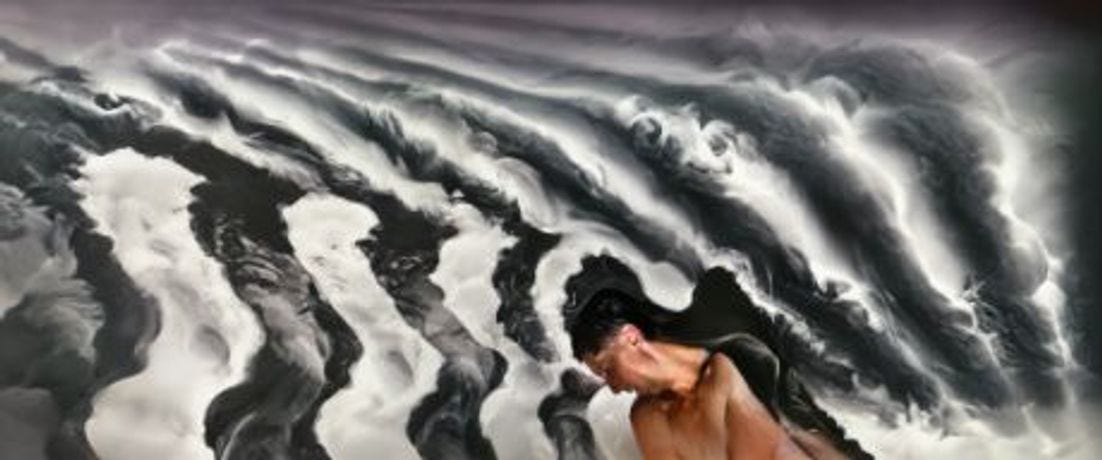Hysteresis, a five minute work by Berlin-based artist Robert Seidel, immerses us into an exuberantly interconnected web of seething, blooming energy, created with layers of animation, live performance, music, and artificial intelligence. Dancer Tsuki improvises (but not, according to Seidel, to the same music we hear on the film, which is by Oval), while Seidel projects his drawings and animations onto her body and the wall behind her. He also processes the projections live, using a variety of software tools, and the AI components are able to take a camera feed of Tsuki’s movements and use them to influence the contours of the projections we see behind her, a visual echo of her dancing.
“Hysteresis” refers to physical phenomena in which the effects lag behind in time from the cause. The title, in one way, refers to the processes which underly the work, in which the dancer’s movements affect the projections, but in a way that slightly lags behind in time. But the verbal association with “hysteria” is also appropriate, as the video’s relentless, ceaseless evolution, the constant explosions into fantastically elaborate structures of ornamentation, has a distinctly manic edge to it.
AI technology takes the abstract imagery of Seidel’s drawings and turns them into explosive animations, seething and surging into a changing sea of imagery, morphing from clouds into stars, trees, faces. The forms suggest, as well, multiple styles and moments from art history: tumbling baroque scenes out of Tiepolo, Ukiyo-e pictures of waves, color field paintings, all transforming so rapidly that your brain can barely register what it’s seeing.
These images resemble the fleeting pictures that run through the mind in a liminal state, just before falling asleep. You might call them image stem cells: units of representation which are in a constant state of potential, about to be born into particular forms, but never solidifying into a single state for more than an instant.
A great amount of the imagery is cloud-like, which feels appropriate. Staring at the clouds and watching them transform from one suggestive shape into another is one common human experience which we can associate with the unstable visual world of Hysteresis.
At one point Tsuki is surrounded by black and white silhouettes of her body, which melt and cut through Seidel’s drawings. Her dancing interacts with the images in a directly physical way, since her limbs and torso are part of the projection surface, and also by having her image fed back into the AI processing of the artwork. Anyone who has experience with psychedelics will recognize what this complex web of interactions looks like: a state of consciousness in which the mind seems to aggressively elaborate on and ornament everything one sees.
Oval’s electronic music compliments the images, with sparkling textures and arpeggios, where each new chord seems to open up and beckon us into a new, breathtaking musical space.
Tsuki, a queerly gendered performer, fits perfectly into an artwork in which all the images are constantly melting through genre barriers. At times, the images evoke a specifically trans eroticism, with abstract, yet sexual forms, which simultaneously evoke male and female bodies.
Hysteresis plunges immediately into its creative maelstrom, and never lets up the pace for its short duration, so if the film does resemble a psychedelic experience, it’s one that doesn’t take up the whole day, and leaves one perfectly intact to pay the bills or take out the garbage afterwards. For those of us who remember the song I Want a New Drug by Huey Lewis, perhaps this is what he was looking for. I wouldn’t apply the label “psychedelic art” to this film, because Seidel’s interests are far broader, harnessing a wide variety of artistic and technological skills to create a dense field of spontaneous interactions and responses. But such a web fascinates us because it resembles so closely the way that the mind works all the time, whether we’re aware of it or not, reflecting the dense interconnections of all existence. Like the psychonaut, Seidel is peering into the mystical web of the mind, and we’re privileged to be taken along for the ride.
My articles on experimental film are freely available to all, but are supported by monthly and annual donations from readers. Please consider becoming a paid subscriber to support my work. Thank you.






I was lucky to see Hysteresis in Vienna and hear Seidel talk about his work in person. I loved this piece too and it was a real standout in the festival. In a world where people are wringing their hands about AI taking away artists' jobs, Seidel found a way to use AI as a way to blend his artwork and Tsuki's performance into something original. Instead of seeming like one of those AI images you get from plugging in a few words into an online image generator, Hysteresis feels artist's vision was brought to life in conjunction with technology. Thanks for writing this really exceptional essay about the film!